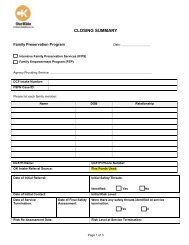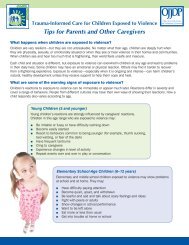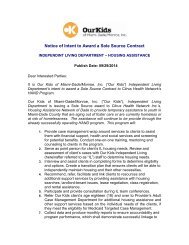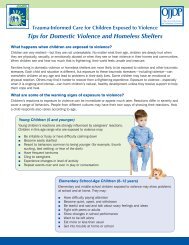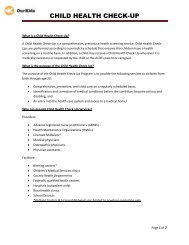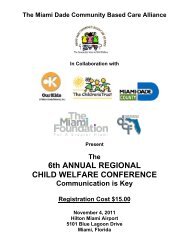Tips for Teachers - Safe Start Center
Tips for Teachers - Safe Start Center
Tips for Teachers - Safe Start Center
Create successful ePaper yourself
Turn your PDF publications into a flip-book with our unique Google optimized e-Paper software.
<strong>Safe</strong> <strong>Start</strong>: Working Together to Help Children Exposed to Violence<br />
Teenagers (13–18 years)<br />
Older children may exhibit the most behavioral changes as a result of exposure<br />
to violence. Depending on their circumstances, teenagers may:<br />
■■<br />
■■<br />
■■<br />
■■<br />
■■<br />
■■<br />
■■<br />
■■<br />
■■<br />
Talk about the event all the time or deny that it happened<br />
Refuse to follow rules or talk back with greater frequency<br />
Complain of being tired all the time<br />
Engage in risky behaviors<br />
Sleep more or less than usual<br />
Increase aggressive behaviors<br />
Want to be alone, not even wanting to spend time with friends<br />
Experience frequent nightmares<br />
Use drugs or alcohol, run away from home, or get into trouble with the law<br />
What can teachers do?<br />
<strong>Teachers</strong> can play a critical role in preventing and<br />
reducing the impact of exposure to violence on children.<br />
They can help children by creating a predictable<br />
environment, listening to students’ stories, and assuring<br />
children and adolescents that whatever happened was<br />
not their fault.<br />
Specific ways to help children exposed to violence<br />
include:<br />
Knowing and watching <strong>for</strong> signs of possible<br />
exposure to violence<br />
No single behavior proves that a child has been exposed<br />
to violence, but teachers can watch <strong>for</strong>:<br />
■■<br />
■■<br />
■■<br />
Physical signs such as bruises<br />
Unexplained changes in behavior<br />
Emotional signs such as depression, mood swings,<br />
and fearful or anxious behavior<br />
Depending on the age of the child, teachers can observe<br />
if a young child is crying more than usual, is difficult to<br />
calm, startles easily, or screams and panics during sleep.<br />
School-age children may become more aggressive and<br />
fight a lot, return to old fears or develop new ones,<br />
become apprehensive about going home, express a<br />
wish that the teacher were the parent, or become overly<br />
active.<br />
Teenagers may use violence to get what they want, rebel<br />
in school, stop being concerned about their appearance,<br />
or refuse to follow rules.<br />
Responding appropriately to children’s disclosures<br />
A teacher’s willingness to listen to a child’s story can<br />
provide the foundation on which to increase resilience<br />
and personal strength. The most meaningful assistance<br />
teachers can offer children exposed to violence is a safe<br />
and com<strong>for</strong>table environment where children can talk.<br />
Students may talk about exposure to violence all at once<br />
or in bits and pieces and “test” the teacher’s responses.<br />
The teacher’s first responsibility is to follow school<br />
policies and procedures and refer the child to specialized<br />
professionals such as the school social worker or<br />
psychologist.<br />
Supporting the healing process<br />
Experts agree that a child’s relationship with a caring<br />
adult is critical <strong>for</strong> developing resilience and beginning<br />
the healing process. It is very important that students<br />
have an opportunity to talk about what they have<br />
witnessed and how they feel with caring teachers who<br />
can listen and understand.<br />
Another important priority <strong>for</strong> teachers is to create an<br />
emotionally safe place <strong>for</strong> all children to learn. These<br />
safe spaces will enable children who have been exposed<br />
to violence to begin their healing journey.<br />
How do you know if more help is needed?<br />
Children exposed to violence may need specialized<br />
assessment and interventions that teachers cannot<br />
provide. If that is the case, teachers should refer<br />
children to other professionals within or outside the<br />
school system. Psychologists, social workers, or school<br />
counselors can help children and their families by<br />
looking at ways to keep current problems from getting<br />
worse. In some instances, they may help families find<br />
ways to stop the cycle of violence.<br />
2 Children Exposed to Violence: <strong>Tips</strong> <strong>for</strong> <strong>Teachers</strong>



